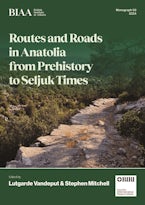Turkey has always been a crossroads and therefore offers an ideal location to study interaction between individuals and human communities and societies through time. Interaction has always necessarily involved movement which in turn did not occur randomly in the landscape, but was instead focused on routes and roads that secured faster and easier connections. There is substantial evidence that exchange networks already existed in Anatolia at least since the Neolithic period, with goods traveling over long distances. From the second millennium BC onwards, textual evidence has improved understanding of traveling routes. The Roman long-distance road network has been a focus of research over decades, but local roads and pathways around individual sites are still mostly unknown. Byzantine roads have also received attention, whereas the Seljuk road and routes system is less well known. It is likely that the younger roads and routes are overlying older ones at least partially, but these palimpsests of older roads are hardly researched. In this volume, experts from different disciplines, using a variety of methods and approaches, aim to transcend the present fragmentation of knowledge and create a new level of understanding of connecting road and route systems in Anatolia throughout time, for the first time.
Acknowledgements
Introduction
1. LV and SM, Routes and Roads in Anatolian Archaeology and History.
Theory and Methods.
2. Wilkinson and Slawisch, Route inertia and route dynamism: myths, materials and landscapes.
3. Foss, Metaphors and methods to study the Lycian Roman road system.
4. Vandeput and Robinson, Roads and Routes through the Taurus Mountains. A Case Study from Pednelissos.
5. Bekker-Nielsen, The Space-Time Economics of Roman Road Design.
Routes before Roads
6. Carter, Obsidian Sourcing and Socio-Economic Interaction: The Contribution of Characterisation Studies to Reconstructing Routeways in Prehistoric Anatolia and the Near East
7. Baysal, Routes without roads: changing dynamics in marine shell use in prehistoric Anatolia.
Roads and Empires
8. Hawkins, Routes in the Hittite Kingdoms.
9. †French, The Persian Road-Network.
10. Mitchell, The Roman road system in Anatolia: organic growth vs. imperial planning.
11. Redford, Caravanserais, Roads, & Routes in Seljuk Anatolia.
Routes and Roads in Western Anatolia
12. Vaessen, Routes and roads in western Anatolia and the eastern Aegean at the end of the second millennium BC.
13. Koçak, The Roman Road from Magnesia to Ephesos
14. Külzer, Routes and Roads in Western Asia Minor: The Lydian Case
Routes and Roads in the southern Tauric regions
15. Iversen, A New Proposal for the Via Sebaste in Sagalassan Territory, and the Roman Roads around Pisidian Konana.
16. Adak, The Road System of Lycia during the Roman Empire.
17. Talloen, The road to salvation: Travel and the sacred along the Imperial Road in Pisidia.
18. Elton, Changes in Routes in the Göksu Valley between the Early Bronze Age and the Karamanids.
The Central Highlands and the East
19. Summers, Humps along the Way: routes, roads and transport on the Anatolian Plateau in the Iron Age.
20. Comfort, Military highways or silk routes? Roads and bridges on the frontier between Rome and Persia in Late Antiquity.
21. Turchetto, From Loulon to the Fortress of the Back Camel. The Routes of the Arab Incursions in Cappadocia.
Indices
Lutgarde Vandeput is the director of the British Institute at Ankara (since 2006). Her fieldwork focuses on Türkiye, specifically in Sagalassos, Aspendos and in the Pisidia Survey Project. As a classical archaeologist (KULeuven, Belgium), she specializes in the study of monumental architecture, settlement development and survey archaeology. Vandeput is involved in the BIAA cultural heritage and sustainable water management projects.
Stephen Mitchell is author of Anatolia: Land, Men and Gods in Asia Minor (2 vols., 1993) and of Cremna in Pisidia: An Ancient City in Peace and in War (CPW/Duckworth, 1995). He directed the Pisidian survey between 1982 and 1996.

